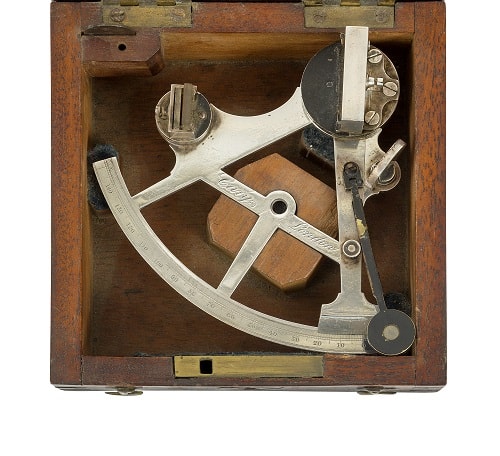- This small silver quintant belonged to Isambard Kingdom Brunel’s second son Henry Marc Brunel. Like his father, Henry was an engineer; he worked on a wide range of projects including Tower Bridge in London.
- The quintant is kept in a wooden box with a brass plaque on the lid engraved with “HM Brunel”. The quintant was made by the instrument manufacturer Cary in London around 1830, twelve years before Henry Brunel was born. It is believed to have been left to Henry by his father following his death. In Isambard Kingdom Brunel’s will it states that all his engineering equipment and publications were to be given to Henry.
- For Victorian engineers, like Henry Brunel, a quintant would have been a useful piece of equipment. When looking at an area of land on which to construct a bridge, tunnel or railway, the quintant could be used to measure the angular distance between two points. This information would help the engineer decide if the land was suitable to be built on.
- Isambard Kingdom Brunel could have used a quintant, like this one, as he tried to find the flattest route for the Great Western Railway between Bristol and London.
The Story
Henry Marc Brunel – Engineer
Born in June 1842, Henry Marc Brunel was the second child of Isambard Kingdom Brunel and Mary Horsley. Like his father and grandfather, Sir Marc Brunel, Henry became an engineer. Isambard was keen for his son to follow in his footsteps and encouraged him in his profession.
Henry spent several years as an apprentice for a few different engineers, including Sir John Hawkshaw, who was one of two engineers to finish building the Clifton Suspension Bridge in Isambard Kingdom Brunel’s memory. Like his father, Henry worked on a range of different types of projects, including tunnels, bridges and railways. In 1866 he was involved in a plan to build a tunnel under the English Channel to link England and France. Henry learnt about geology so that he could help with the initial stages of the project, but it was abandoned before any part of the tunnel was dug.
Henry Brunel also designed a ship, the SS Chauncy Maples which, like the SS Great Britain, was a steamship with a screw propeller. She is still afloat today though her steam engine was replaced with a diesel engine in 1967.
Later in life, Henry worked alongside his older brother, Isambard Junior, to write books about their father and help to protect Isambard Kingdom Brunel’s legacy.



